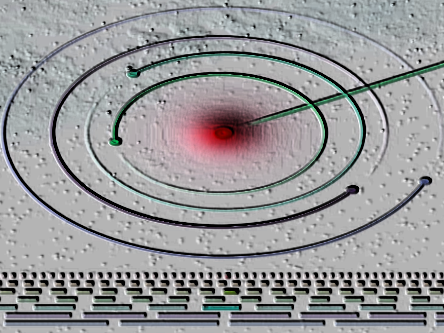Imagine what Kepler himself would have thought about the excitement and knowledge he and Pythagoras inspired regarding the cosmic music created by the moving bodies in the solar system and beyond.
Have you ever wondered what the sounds of the stars would sound like – if only there was a medium for sound to travel through the cosmos? In these audio pieces, a number of Kepler fans have created an array of musical masterpieces they believe represent what we and Johaness Kepler would have heard when listening in to the harmonies created by the bodies in our Universe.

Milky Way Gas Disc Represented as Musical Notes
First UP, here is the audio created by an algorithm developed by Mark Heyer of the University of Massachusetts Amherst. It expresses the movement of gases in the Milky Way’s disc as musical notes. “This musical expression lets you ‘hear’ the motions of our Milky Way galaxy,” Heyer says. “The notes primarily reflect the velocities of the gas rotating around the centre of our galaxy.”
Mark continues, “Each observation is represented by a line showing where the telescope was pointing and the positions of the circles along a line show the locations of the gas in the galaxy responsible for the played notes,”
Read more about it at https://www.sciencealert.com/milky-way-rotation-data-transcribed-as-jazz-music and at the university site at https://www.umass.edu/newsoffice/article/umass-amherst-astronomer-composes-galactic.
Near-perfect Planetary Resonances
Second up comes a piece created by exoplanet hunters that have made one of their most unusual discoveries: a system called K2-138 that contains five planets orbiting in near-perfect resonances so close to their star that all five orbits are less than 13 days.
In the article, orbital resonances are explained as the phenomenon that occurs when planetary orbits are spaced so that they circle their star in numerically related patterns. Kepler would have loved to investigate these relationships, especially because K2-138’s resonance is close to 3:2, which means that each planet makes three circuits of the star in the time it takes the next one out to make two.
Such resonances are common in the planetary systems discovered by NASA’s Kepler space telescope (which seeks exoplanets by looking for dips in the brightness of distant stars that occur when planets cross in front of them, blocking part of their light). Check out the audio they created from these cosmic harmonies…
For more information read an interview with one of the creators at https://cosmosmagazine.com/space/music-of-the-spheres-chain-of-planets-rotates-at-perfect-fifth-intervals
TRAPPIST-1 Planetary System Translated Directly Into Music
Finally, among the astronomical audio files that can be found on https://astrosom.com we have TRAPPIST-1 Planetary System Translated Directly Into Music. Here you can hear
“We used a numerical simulation of TRAPPIST-1 to play a piano note every time a planet passes in front of the star (a ‘transit’) and a drum every time a faster inner planet overtakes its outer neighbour (a ‘conjunction’).” System Sounds explains.
“To assign pitches, we simply scaled up the orbital frequencies by 212 million times to bring them into the human hearing range. The TRAPPIST-1 system is a resonant chain which means that the periods of the planets’ orbits are very close to whole number ratios (ex. 3:2, 4:3). This is exactly what makes two musical notes sound consonant when played together and as a result, TRAPPIST-1 creates a beautiful, but slightly twisted harmony.”
For the same reason, the transits and conjunctions occur in a steady, repeating pattern. The crackling sound heard towards the end is Kepler’s K2 lightcurve data of the star’s observed brightness sped up by many times.” Check out the audio…
For more information on how this was done, read the New York Times article at https://www.nytimes.com/2017/05/10/science/trappist-earth-size-planets-orbits-music.html and be sure to like, comment and subscribe to the above YouTube video channels to get more sounds of the stars that our genius astronomer, mathematician and musician would have loved to experience.
No Comment
You can post first response comment.